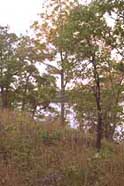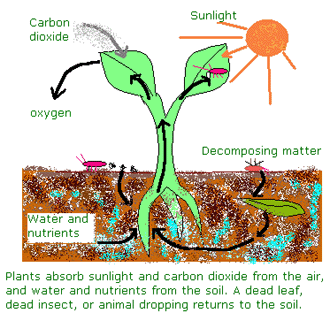
 |
The term 'barrens' describes a variety of dry forests with open canopies. Early settlers used the term interchangeably with 'openings,' (which may refer to a type of savanna). A recent study of twenty-two xeric (dry) forests on different soils and bedrock in Illinois resulted in the definition of barrens as plant communities characterized by widely spaced trees (no greater than 50% woody cover) and a codominant understory of grasses and other prairie plants. |
Barrens are a unique combination of forest (oak) opening and prairie, surrounded by mesic or dry upland forests (which have greater tree cover and less herbaceous cover than barrens).
Barrens are restricted to poor, thin, or excessively drained soils over bedrock that is often exposed in places. Because these soils contain little moisture or plant nutrients, the trees growing on them often have a stunted or gnarled growth form.
Barrens are typically dominated by post oak (Quercus stellata) with black oak (Quercus velutina), blackjack oak (Quercus marilandica), black hickory (Carya texana), and sometimes, Spanish oak (Quercus falcata) in the canopy
The understory is usually dominated by little bluestem and big bluestem grasses (Andropogon scoparius and Andropogon gerardii, respectively) and other prairie plants. Shrubs may include blueberry (Vaccinium arboreum) and hazel (Corylus americana) which were formerly much more abundant.
Where
are barrens found in Illinois?
Barrens
occur mostly in the southern and western portions of the state along ridge
tops and south and southwest facing slopes. They are present in the Shawnee
Hills and the Cretaceous Hills in the southernmost part of the state.
The barrens in the extreme southern portion of the state (southern portions of Alexander, Pulaski, and Massac counties) have a better-developed soil layer and are less dry than those in the Shawnee Hills and those on dry ridges along rivers in western parts of the state. These barrens are rare and support a greater diversity of forest vegetation, including white oak and Spanish oak, with big bluestem and little bluestem in the understory.
Barrens
Trees' Adaptations
Barrens are generally droughty. Some data suggest that oak trees in barrens slow their nutrient uptake when soil moisture is low. The dominant oaks growing in barrens (post oak, black oak, and blackjack oak) exhibit a number of adaptations to drought and low levels of nutrients in the soil.
- The tough, leathery leaves have a waxy surface coating and remain on the tree late into the season.
- The tree withdraws the nutrients from the leaves before they fall from the tree.
- The tough, low-nutrient leaves are not an attractive food source to herbivores such as microorganisms, insects, and worms that eat leaf litter and excrete nutrients and carbon into the soil. These microorganisms, insects, and worms are slow to break down the tougher, unpalatable leaves. This causing a slow rate of nutrient cycling in these soils.

The
role of fire in barrens forests
In the past, frequent ground fires would also have played a major role in nutrient cycling breaking litter down quickly. Barrens were once common in Illinois, but are now rare. They depend on fire for the maintenance of their open-canopy
and high light environment. Prior to European settlement, frequent fires
limited tree growth and prevented shrubs from gaining a foothold and dominating
the understory. The open canopy resulted in high light levels necessary
for the prairie grasses and forbs.
Fire suppression
by humans, grazing, logging, and cultivation have degraded most of the
original barrens in the state. The existing barrens in Illinois are probably
remnants of communities that were more extensive prior to the 1900s. They
are probably the result of a disturbance such as fire (used to maintain
the barrens as a protected natural area) or the result of their location
on rocky, thin soils or on excessively drained slopes with thin soils.
|
|
Copyright © 2000 Illinois State Museum